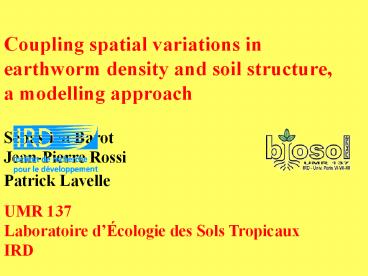BIOLOGIE DES RACINES - PowerPoint PPT Presentation
Title:
BIOLOGIE DES RACINES
Description:
Title: BIOLOGIE DES RACINES Author: barot Last modified by: qdqd Created Date: 11/11/2003 11:07:57 AM Document presentation format: Affichage l' cran – PowerPoint PPT presentation
Number of Views:96
Avg rating:3.0/5.0
Title: BIOLOGIE DES RACINES
1
Coupling spatial variations in earthworm density
and soil structure, a modelling
approach Sébastien BarotJean-Pierre
RossiPatrick Lavelle UMR 137Laboratoire
dÉcologie des Sols TropicauxIRD
2
Soil fauna tends to have heterogeneous spatial
distributions
A
Earthworms Large patches with higher densities
B
(A) Density of the earthworm Chuniodrilus zielae
and (B) Millsonia anomala (juvenile) in the
savanna of Lamto (Rossi Lavelle, 1998)
3
What are the causes of soil fauna
distribution? Preexisting soil heterogeneity?
- ? Heterogeneous distribution of plant litter and
roots - ? Heterogeneity of soil structure (granulometry,
soil aggregate size) - ? Heterogeneity in chemical properties ?
Content in organic matter and mineral nutrients
4
Yet, data analyses show that
? Soil heterogeneity is correlated with soil
fauna distribution
? But the greatest part of the heterogeneity
in soil fauna density is not explained by
soil heterogeneity (Decaëns 2001, Whalen
2003)
? Can the own dynamics of soil fauna lead
to complex spatial patterns? Mobility?
Mortality? Spatially dependent factors of
auto-regulations? ? This hypothesis was tested
using a spatially explicit simulation model
5
Description of the model 1 the biology
? In the savannas of Lamto (Côte dIvoire), the
earthworm Millsonia anomala compacts the soil
by only ingesting small aggregates and by
producing large size casts (Øgt 5 mm )
(Blanchard 1997)
? Large aggregates are broken into smaller ones
by weathering, roots, and earthworms of the
eudrilidea family, which are able to dig into
large aggregates, and produce small casts
(5 mmgtØ )
? Experiments suggest that mortality
increases when soil structure becomes too
unfavorable not enough small aggregates ?
Hypothesis of auto-regulation by the
availability of small aggregates
6
Description of the model parameters
? A cellular automaton (50 X 50 cells), each cell
(1 m2) defined by M. anomala density (nT),
and the percentage of soil mass in small
aggregates (sp1)
? Annual rate of production of coarse aggregates
by an earthworm (C), rate of destruction of
these aggregates for a mean eudrilidea
density (D)
? Fecundity (b), minimum mortality (dmin),
sensitivity of mortality to of thin
aggregates (ed)
? Dispersal follows a normal law
7
Analysis of the model
? All parameters but the mobility and the
sensitivity of mortality to soil aggregation
can be assessed using field studies
? Comparison with observed patterns
? Variance and mean of the density ? Spatial
distribution
Spatial autocorrelation
Semivariance
Distance
8
First results 1 fecundity 2, only mortality
depends on soil structure, mortality then
dispersal
9
First results 2 fecundity 2, only mortality
depends on soil structure, mortality then
dispersal
Spherical model
10
How do we get some spatial structure?
- ? Increased fecundity
- ? Dispersal before mortality
- ? Dependence of mortality and fecundity on soil
aggregation is sufficient to get long range
spatial structures - ? Dependence of dispersal on soil aggregation is
not sufficient - ? Very complex spatial patterns arise for
certain combinations of parameters values
11
An example fecundity 4, only mortality depends
on soil structure, dispersal then mortality
50 m
Semivariance
30
30
15
0
15
0
Distance (m)
12
Discussion 1 interpretation of the results
? The own dynamics of earthworms can lead to
long range spatial structures? This arises
when sensitivity of fecundity or mortality to
soil aggregation is high, and when mobility
is very low ? This suggests that it is
really the case ? In these cases the simulated
mean and standard deviations of the density
are compatible with values observed in the
field
13
Discussion 2 limitations and further analyses
- ? No size structure, no temporal variation in
parameters although they probably depend on
climatic variations - ? The dynamic of decompacting earthworms is not
taken into account - ? Soil organic matter is not taken into account
?Link earthworm demographic parameters to
ecosystem properties such as the
mineralization rate - ? Experimental work ? To measure the sensitivity
of parameters to soil aggregation ? To
measure mobility































